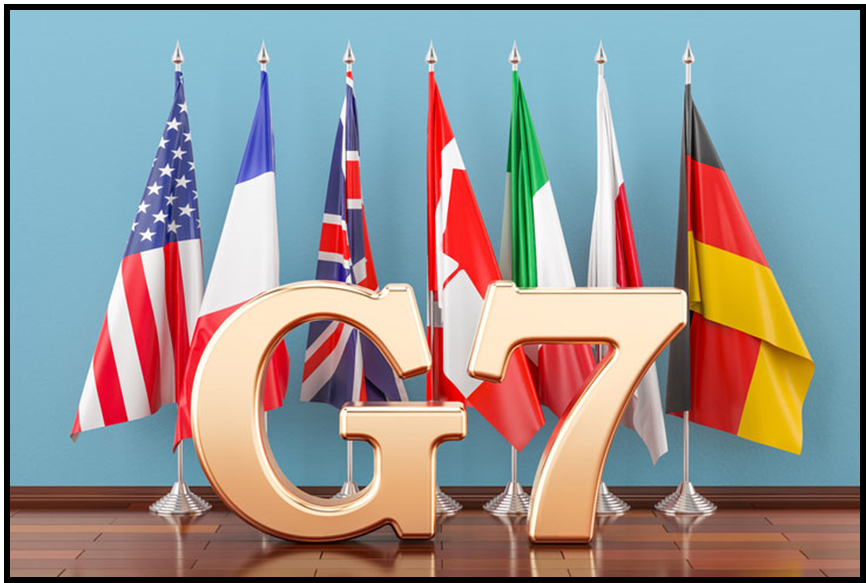G-7 OUTREACH SUMMIT: SHIFTING DYNAMICS AND GLOBAL ENGAGEMENTS
Syllabus:
- GS-2- International relations and forums , Shaping of Global geopolitics
Focus :
- The article examines the changing dynamics of the G-7 Summit, highlighting Italy’s initiative to include Global South countries, the group’s declining influence amidst global challenges, and the role of India. It underscores the need for the G-7 to reassess its identity and purpose in a rapidly evolving global landscape.
Source - TET
Introduction
- G-7 Outreach Summit Invitation: Italy’s Prime Minister Giorgia Meloni invited leaders from 10 countries, including Prime Minister Narendra Modi, to the “G-7 Outreach” Summit.
- Global South Inclusion: The invitation aimed to move beyond the “West vs the Rest” paradigm, engaging BRICS countries such as Brazil, India, and the UAE, and seven African nations on energy issues.
Historical Context and Evolution of the G-7
- Origins and Purpose: Initially, the G-7 was celebrated as a dynamic group of the world’s most developed democracies focused on addressing global financial and development issues.
- Challenges and Decline: Recent challenges such as manufacturing slowdowns, the COVID-19 pandemic, and geopolitical tensions like the Russia-Ukraine conflict have diminished the group’s effectiveness.
Summit Highlights
- Venue and Host: The summit was held in the Mediterranean Apulia region, symbolizing a bridge between the West and the Global South.
- Italy’s Strategic Invitations: Italy’s decision to involve mainly Global South countries reflects a strategic shift to more inclusive global discussions.
Key Outcomes and Discussions
- Joint Communiqué: The communiqué was extensive but lacked concrete action plans, addressing issues like support for Ukraine and criticisms of China’s industrial practices.
- Ukraine Support: The G-7 reaffirmed its support for Ukraine, including military and humanitarian aid, without offering a clear path to ending the conflict.
- Gaza Ceasefire: The appeal for a ceasefire in Gaza was not accepted by Israel.
Critical Perspectives
- China Focus: The G-7’s sharp focus on China in the Indo-Pacific and its industrial practices highlighted geopolitical tensions but showed uncertainty regarding members’ economic ties with Beijing.
- Infrastructure Corridors: The communiqué recommitted to various infrastructure projects, including the India-Middle East-Europe Corridor, but lacked execution plans.
India’s Role and Perspectives
- India’s Eleventh Attendance: Prime Minister Narendra Modi attended the summit for the eleventh time, reflecting on India’s engagement with global leadership.
- Modi’s Focus: Modi emphasized India’s democratic values, technological advancements, and the importance of the Global South, particularly Africa.
- Bilateral Meetings: Notably, formal bilateral meetings with key partners like the U.S. and Canada did not materialize.
G-7’s Future and Relevance
- Identity and Purpose: The summit raised questions about the G-7’s current relevance and effectiveness, suggesting a need for the group to redefine its role in a changing global order.
- Engagement with Global South: The inclusion of Global South countries hints at a potential shift in G-7’s strategy to remain relevant.
Conclusion
- Summit Summary: The G-7 Outreach Summit reflected a transitional phase for the group, highlighting the need for reassessment amidst global power shifts.
- India’s Strategic Reflection: India’s participation offered a platform for global engagement but underscored the limitations of the summit in delivering substantial outcomes.
Source:The Hindu
Associated Article :
https://universalinstitutions.com/a-reboot-at-g7/
Mains Practice Question :
GS-2
“Discuss the evolving role and challenges of the G-7 in the current global geopolitical landscape. How has the inclusion of Global South countries in the recent G-7 Outreach Summit impacted the group’s dynamics and effectiveness? Illustrate with examples from the summit.”(250 words)




